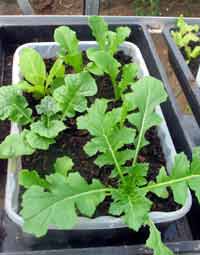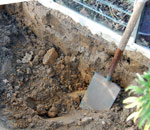Using Greenhouses to Extend the Growing Season
Using greenhouses and cold frames to extend the growing season for vegetables and salad crops makes sense for those of us in the chillier parts of the world. You can start seedling plants which would otherwise struggle outdoors in early spring and you can carry on cropping from mature plants well into autumn.
So what are the best ways of using greenhouses for home crops?
Sponsored links
|
As with so many aspects of gardening, it rather depends upon what you want.
Most amateur gardeners have not the time and dedication to heat the greenhouse throughout the chilly months. Nevertheless the greenhouse can be a valuable asset at almost any time of the year.
Here are some ways of using greenhouses to extend the season, mainly for food crops, without additional heating.
Using greenhouses and cold frames to start off seedlings
If you have no heating at all and you are in a temperate part of the world, you will probably need to use a heated propagator for starting off your seedlings. An unheated greenhouse will be too cold for early crops.
Later in the year (around April onwards for the UK,) seedlings will often thrive without extra heat. You need either a good bench or work surface (staging) in the greenhouse or alternatively a seed tray stand. The seedling trays should be kept off the floor as that is the coldest spot in the greenhouse.
Cold frames can also be used but you may need to supply some kind of heat until the frosty months are past. If you have a greenhouse and some unheated propagators this can be a part solution. Start seedlings inside the house in the propagators and move them outside when they are seedlings have germinated.
A double thermometer is a useful tool as it allows you to see the lowest temperature of the previous night. You can use this to help you judge when it is warm enough for any particular seedling to be put into the greenhouse. (The maximum temperature shown also helps you plan your greenhouse's ventilation.)
If you want a good guide to greenhouse or sunhouse growing, consider the Greenhouse Gardener's Companion
for a good all round manual which covers just about everything - and it's quite humorous too!
Using greenhouses for growing on seedlings

Many of the smaller vegetables can be given a good and early start by growing them on in the greenhouse. Beans, especially dwarf varieties can be grown in pots and tubs. Some, such as French dwarf beans can even be grown to maturity in the greenhouse.
Leeks and onions can be started in boxes of soil. Cabbage family seedlings can be given a good head start by keeping them inside the greenhouse for a few weeks.
All these plants will need to be hardened off gradually before they are put out into their permanent quarters.
Using greenhouses, picture right: salad crop seedlings can get a quick start in the greenhouse during spring or autumn
Using greenhouses for over-wintering crops
Growing herbs in winter
The greenhouse can be used for extending the life of annual herbs such as mint or parsley. Pot up a big planter and you should enjoy many herb varieties right into the depths of winter, or even all year.
Planting in the soil
Most greenhouse crops can be planted directly into the soil and in some ways this is preferable to planting in pots and grow bags. Pots and grow bags are very unforgiving when it comes to watering. You must either water practically every day or you must set up a drip feed system to keep plants well irrigated. Also, grow bags and pots are more likely to run out of fertility that good quality soil. Plants in real soil have the option of going deeper to find the nutrients they need.
The other side of the coin is that soil based plants have to be given fresh, disease-free soil to grow in. This means in practice that it's a good idea to change the soil in the greenhouse every year or two. Dig the existing soil out to a depth of two spade depths (two spits) and remove it to elsewhere in the garden. It can still be used; just don't use it for any of the same plants that grew in it in the greenhouse.

Replenish the soil with good quality earth with fresh well-rotted compost mixed in. You might also want to mix in a little organic fertiliser, for example some "Six X" or some organic chicken manure. Take soil from somewhere where you know plants you are growing have not previously grown.
When I did this at the end of last year I dug up part of the lawn! You don't need to go to those lengths but it's good to be sure that your soil is disease free. You can buy topsoil in most garden centres if need be.
Picture, right: it's a good idea to renew the soil every year or two
Using greenhouses on hard bases
If your greenhouse stands on a solid base such as slabs or concrete then you will need to adapt to growing everything in tubs, planters and pots. Grow bags are very useful for larger plants such as tomatoes and cucumbers but, as noted above, frequent watering is a must.
Using staging and capillary matting
Staging or some kind of shelving is a great asset in the greenhouse and many greenhouse companies do a variety of adaptable systems to suit all pockets. Whether you opt for slatted staging or removable trays good capillary matting can help with keeping plants well irrigated. Lay down a layer of plastic sheeting first if you are using slats or wooden shelves.
Growing small plants in the greenhouse
Shading when summer arrives
If you want a more permanent solution to greenhouse shading, you can buy blinds for most types of greenhouse.
 The Greenhouse Gardener's Companion The Greenhouse Gardener's Companion |
Weeding
Watering and ventilation
Plants in greenhouse need to be kept well watered and the soil needs to be kept moist. In the warmer months it can be beneficial to lightly spray paths and borders with water to help keep the environment cool and damp enough. How much you do this will depend upon what you are growing and the outside temperatures. In cooler months and in winter too much moisture is best avoided as it promotes rot and fungus attacks.
It's best to use a can fitted with a fine nozzle for watering the greenhouse. This is especially so when you have seedling plants which are vulnerable to being knocked over by the more powerful sprays. You can use a hose, too though you will get better results with water from rain butt rather than chlorinated tap water. If you do use a hose, it helps to fit a pressure control valve to regulate the flow. A long-spouted watering can is useful for reaching plants in the far corners of the house.
Seedling crops are also vulnerable to sudden changes in water temperature. To avoid this, fill up your watering cans after each watering and leave them inside the greenhouse to warm up to the same temperature. If you water daily this will give the water plenty of time to catch up. Another solution is to keep a small water tank inside the greenhouse, under the staging. Keep it covered to avoid the build-up of algae.
Ventilation
The air in a greenhouse needs to be moving slightly to avoid fungus problems. In all but the very coldest weather keep the side ventilators slightly open, at least during the day.
Sponsored links
Keeping it all clean
Another thing to be aware of when using greenhouses for growing crops is that everything needs to kept clean. Any dead plants should be tidied away and composted, unless they are diseased (burn or bin them). The windows of the greenhouse should be washed with vinegar and water (just a capful in a bucket of water is enough) to ensure good light penetration. This will also help to deter mildew and other moulds from taking hold.
At the end of the season clean everything thoroughly. Wash all the whole greenhouse, equipment and stands.

Custom Search
Return from Using Greenhouses back to Green Grow - How to Groww a Vegetable Garden
Greenfootsteps Home - for more easy green living ideas
Using Greenhouses to Extend the Growing Season
Copyright Greenfootsteps.com 2009
Please do not copy without permission. This site is protected by Copyscape






New! Comments
Have your say about what you just read! Leave me a comment in the box below.